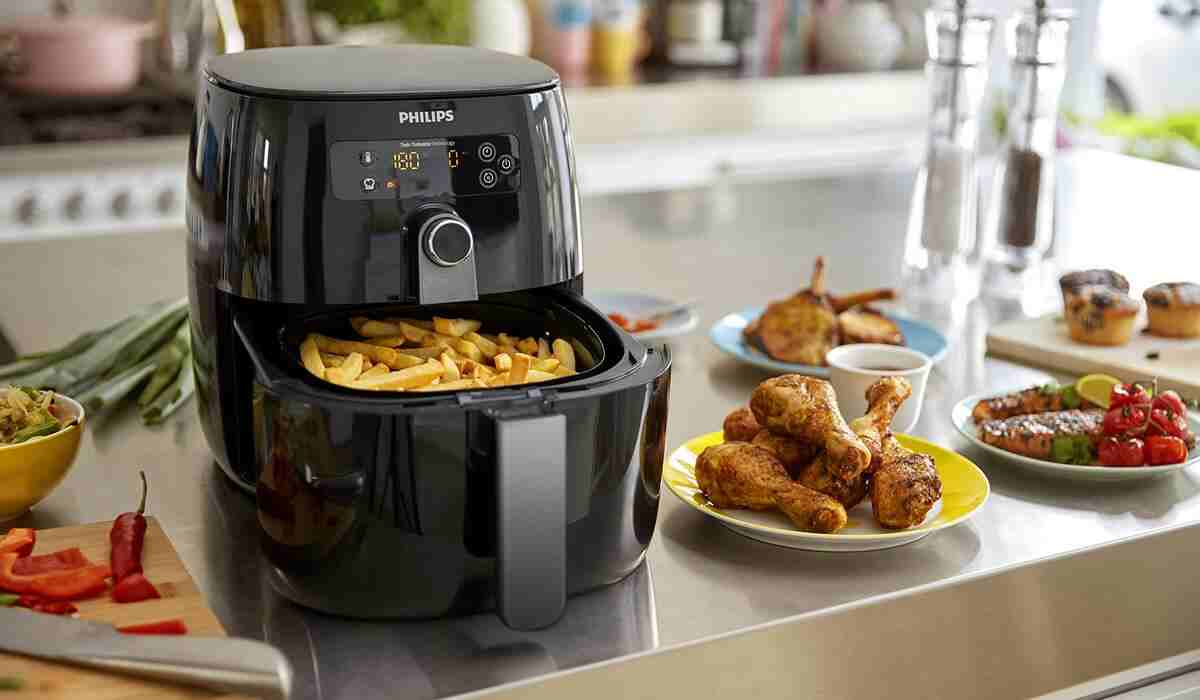Table of Contents
What Is an Air Fryer?
An air fryer is a kitchen appliance designed to cook food by circulating hot air around it using convection technology. It is a popular alternative to traditional deep frying, as it can produce crispy and evenly cooked food with significantly less oil or fat.
The air fryer typically consists of a heating element and a powerful fan that circulates the hot air inside the cooking chamber. When you place food inside the fryer’s basket or tray, the hot air rapidly circulates around the food, cooking it from all angles. This circulating hot air creates a similar effect to deep frying but without the need for excessive oil.
Air fryers are versatile and can be used to cook a wide range of foods, including but not limited to, french fries, chicken wings, fish, vegetables, and even baked goods like muffins or cookies. Some air fryers also come with additional features such as grilling, baking, and roasting functions, expanding their culinary capabilities.
One of the main advantages of using an air fryer is that it significantly reduces the amount of oil needed for cooking. It can achieve crispy and golden results with just a fraction of the oil that would be used in traditional deep frying methods. This makes it a healthier option for those who want to enjoy fried foods with less fat and fewer calories.
Air fryers are generally easy to use, featuring temperature and time controls that allow you to set the desired cooking parameters. They also often have a removable basket or tray, making it convenient to clean up after cooking.
It’s important to note that while air fryers can produce delicious and healthier versions of fried foods, they may not provide the exact same taste and texture as deep frying. The results can vary depending on the specific model of the air fryer and the type of food being cooked.
How Air Fryers Work?
Air fryers work by using convection technology to cook food with hot air. Here’s a step-by-step explanation of how they work:
- Heating Element: Air fryers have a heating element, usually located at the top or bottom of the appliance. When you turn on the air fryer and set the desired temperature, the heating element starts to generate intense heat.
- Convection Fan: Inside the air fryer, there is a powerful fan that is responsible for circulating the hot air. The fan is usually located above the heating element. As the heating element produces hot air, the fan immediately starts to blow the air around the cooking chamber.
- Cooking Chamber: The cooking chamber is where you place the food you want to cook. It is typically a basket or tray that allows the hot air to circulate around the food evenly. The basket or tray is designed to allow the hot air to flow through and reach all sides of the food.
- Rapid Hot Air Circulation: The fan creates a strong and rapid airflow that circulates the hot air throughout the cooking chamber. This circulating hot air transfers heat to the food from all angles, cooking it quickly and evenly.
- Maillard Reaction: As the hot air circulates around the food, it causes the Maillard reaction to occur. The Maillard reaction is a chemical reaction between amino acids and reducing sugars in the food, resulting in browning and the formation of delicious flavors and aromas.
- Crispy Texture: The rapid circulation of hot air in the air fryer helps to remove moisture from the food’s surface, leading to a crispy texture. This mimics the texture of deep-fried food without the need for excessive oil.
- Cooking Controls: Air fryers typically come with temperature and time controls. You can set the desired temperature and cooking time based on the specific food you are preparing. The controls allow you to customize the cooking process according to your preferences.
- Oil or Spray: While air fryers require significantly less oil than deep frying, some recipes may benefit from a light coating of oil or cooking spray. Adding a small amount of oil can help enhance the crispiness and flavor of certain foods.
- Easy Cleanup: Most air fryers come with a removable basket or tray that makes it easy to clean after cooking. The non-stick coating on the basket or tray prevents food from sticking, simplifying the cleaning process.
By utilizing convection technology and hot air circulation, air fryers offer a healthier cooking method for achieving crispy and evenly cooked results. They are efficient, convenient, and can be used for a variety of foods, making them a popular kitchen appliance for many households.
Benefits of Using an Air Fryer
Using an air fryer offers several benefits compared to traditional cooking methods. Here are some of the advantages of using an air fryer:
- Healthier Cooking: One of the primary benefits of using an air fryer is that it allows you to cook with significantly less oil compared to deep frying. Air fryers require only a fraction of the oil traditionally used, yet they can still achieve crispy and delicious results. This reduction in oil consumption can help lower the overall fat and calorie content of your meals, making them a healthier option.
- Reduced Fat Intake: By using less oil, air frying can help reduce your intake of unhealthy fats. Deep frying often results in food absorbing a significant amount of oil, which can contribute to weight gain and various health issues. Air frying allows you to enjoy crispy and flavorful food without the excess fat, making it a more waistline-friendly option.
- Versatility: Air fryers are versatile appliances that can cook a wide range of foods. Whether you want to make french fries, chicken wings, vegetables, fish, or even baked goods like muffins or cookies, an air fryer can handle it. Some air fryers also come with additional cooking functions, such as grilling, baking, and roasting, allowing you to experiment with various recipes and expand your culinary repertoire.
- Faster Cooking Time: Air fryers cook food faster than traditional ovens or stovetops. The rapid circulation of hot air ensures that the heat is evenly distributed, resulting in faster cooking times. This can be particularly beneficial when you’re in a hurry or want to prepare a quick meal without compromising on taste and texture.
- Energy Efficiency: Air fryers are generally more energy-efficient than conventional ovens. They use less power and heat up faster, which can help save energy and reduce your electricity bills in the long run.
- Easy to Use and Clean: Air fryers are designed to be user-friendly. They often come with simple controls, allowing you to adjust the temperature and cooking time with ease. Additionally, many air fryer models have dishwasher-safe components, such as the cooking basket or tray, making cleanup a breeze.
- Safer Alternative: Air fryers provide a safer alternative to traditional deep frying methods. With less oil involved, there is a reduced risk of hot oil splatters and burns. This makes air frying a safer option, especially when cooking with children or in a busy kitchen.
- Odor and Smoke Reduction: Deep frying can often result in strong odors and smoke lingering in the kitchen. Air fryers help minimize these issues since they produce less smoke and have built-in filters to control odors. This is particularly advantageous for those who have sensitive noses or live in apartments or small spaces where odors can be more noticeable.
While air fryers offer numerous benefits, it’s important to note that they may not produce the exact same taste and texture as deep frying. The results can vary depending on the specific model of the air fryer and the type of food being cooked.
Types of Air Fryers
There are several types of air fryers available on the market, each with its own features and designs. Here are some common types of air fryers:
- Basket-Style Air Fryers: Basket-style air fryers are the most common type. They feature a removable basket where you place the food for cooking. The basket is typically equipped with perforations to allow hot air to circulate around the food. These air fryers often have a drawer-style design, with the basket sliding in and out of the cooking chamber.
- Oven-Style Air Fryers: Oven-style air fryers resemble traditional convection ovens. They have a larger cooking capacity compared to basket-style models and often feature multiple racks or shelves to cook different foods simultaneously. Oven-style air fryers may also have additional cooking functions such as baking, toasting, and dehydrating.
- Toaster Oven with Air Fryer: This type of air fryer combines the functionalities of a toaster oven and an air fryer into one appliance. It allows you to toast bread, bake, broil, and also air fry food. It is a versatile option for those who want the convenience of both appliances in a single unit.
- Paddle-Type Air Fryers: Paddle-type air fryers, also known as stirring or rotating air fryers, have a unique design that includes a stirring mechanism. They feature a paddle or stirring arm that rotates the food during cooking, ensuring even cooking and reducing the need for manual shaking or flipping of the food.
- Compact Air Fryers: Compact air fryers are smaller in size and are ideal for individuals or small households with limited kitchen space. They have a smaller cooking capacity but still offer the same air frying benefits. Compact air fryers are often portable and convenient for quick meals or snacks.
- Oil-Less Air Fryers: Oil-less air fryers are designed to cook food without the need for any oil. Instead of using oil, they rely on the hot air circulation to achieve a crispy texture. These air fryers are suitable for those who prefer to cook with minimal or no added oil for dietary or health reasons.
It’s important to consider factors such as cooking capacity, additional features, ease of use, and your specific cooking needs when choosing the right type of air fryer for you. Each type has its own advantages and considerations, so it’s worth researching and comparing different models before making a purchase.
Tips for Using an Air Fryer
Certainly! Here are some helpful tips for using an air fryer effectively:
- Preheat the Air Fryer: Preheating the air fryer for a few minutes before adding the food can help ensure even cooking and better results. Many air fryers have a preheat function, but if yours doesn’t, simply set it to the desired temperature and let it run for a couple of minutes before adding your food.
- Don’t Overcrowd the Basket: To achieve crispy and evenly cooked food, avoid overcrowding the air fryer basket or tray. Leave some space between the food items to allow proper air circulation. If you have a large quantity to cook, it’s better to do it in batches for optimal results.
- Lightly Oil or Spray the Food: While air fryers require less oil than traditional frying methods, a light coating of oil or cooking spray can enhance the texture and flavor of certain foods. Use a brush or spritz the food with a small amount of oil before placing it in the air fryer. This step is particularly beneficial for achieving a golden and crispy exterior.
- Shake or Flip the Food: For even cooking, consider shaking the basket or flipping the food halfway through the cooking process. This helps ensure that all sides of the food are exposed to the hot air and promotes uniform browning. You can set a timer to remind you to shake or flip the food.
- Adjust Cooking Time and Temperature: Air fryers may cook slightly differently than traditional ovens, so it’s important to adjust the cooking time and temperature accordingly. Start with the recommended cooking times provided in recipes or the appliance’s manual, and then make adjustments based on your preferences and the specific food being cooked.
- Use Parchment Paper or Aluminum Foil: To make cleaning easier and prevent sticking, you can line the air fryer basket or tray with parchment paper or aluminum foil. Ensure that the paper or foil doesn’t cover the entire basket, as it can obstruct the air circulation. Make a few small slits to allow the air to flow freely.
- Monitor the Cooking Process: Keep an eye on your food while it’s cooking in the air fryer. This allows you to check for doneness and prevent overcooking or burning. You can pause the cooking process, open the air fryer, and check the food’s progress as needed.
- Experiment with Seasonings and Marinades: Air fryers offer a great opportunity to experiment with different seasonings, herbs, and spices. Don’t be afraid to try out different marinades or spice blends to enhance the flavor of your food. The hot air circulation helps to intensify the flavors.
- Clean the Air Fryer Properly: After using the air fryer, make sure to clean it thoroughly according to the manufacturer’s instructions. Most air fryers have dishwasher-safe parts, such as the basket or tray, which can be easily cleaned. Wipe down the interior and exterior of the air fryer with a damp cloth.
By following these tips, you can make the most of your air fryer and achieve delicious and crispy results with a variety of foods. Remember to consult the specific instructions provided with your air fryer for any additional guidelines or recommendations.
Conclusion
Air fryers are versatile kitchen appliances that offer a healthier alternative to traditional deep frying. They use convection technology to circulate hot air around the food, resulting in crispy and evenly cooked dishes with significantly less oil. By using an air fryer, you can enjoy the texture and taste of fried foods without the excess fat and calories.
The benefits of using an air fryer include healthier cooking with reduced oil consumption, faster cooking times, energy efficiency, versatility in preparing a variety of foods, and easy cleanup. Air fryers are also safer to use than deep frying methods, as they minimize the risk of oil splatters and burns.
To make the most of your air fryer, consider preheating it, avoiding overcrowding the basket, lightly oiling or spraying the food, and periodically shaking or flipping it for even cooking. Adjusting cooking times and temperatures, using parchment paper or aluminum foil for easier cleanup, and experimenting with seasonings and marinades can further enhance your culinary creations.
With their convenience and ability to produce delicious, healthier meals, air fryers have become a popular addition to many kitchens. Whether you’re craving crispy fries, juicy chicken wings, or roasted vegetables, an air fryer can help you achieve satisfying results with less guilt.




